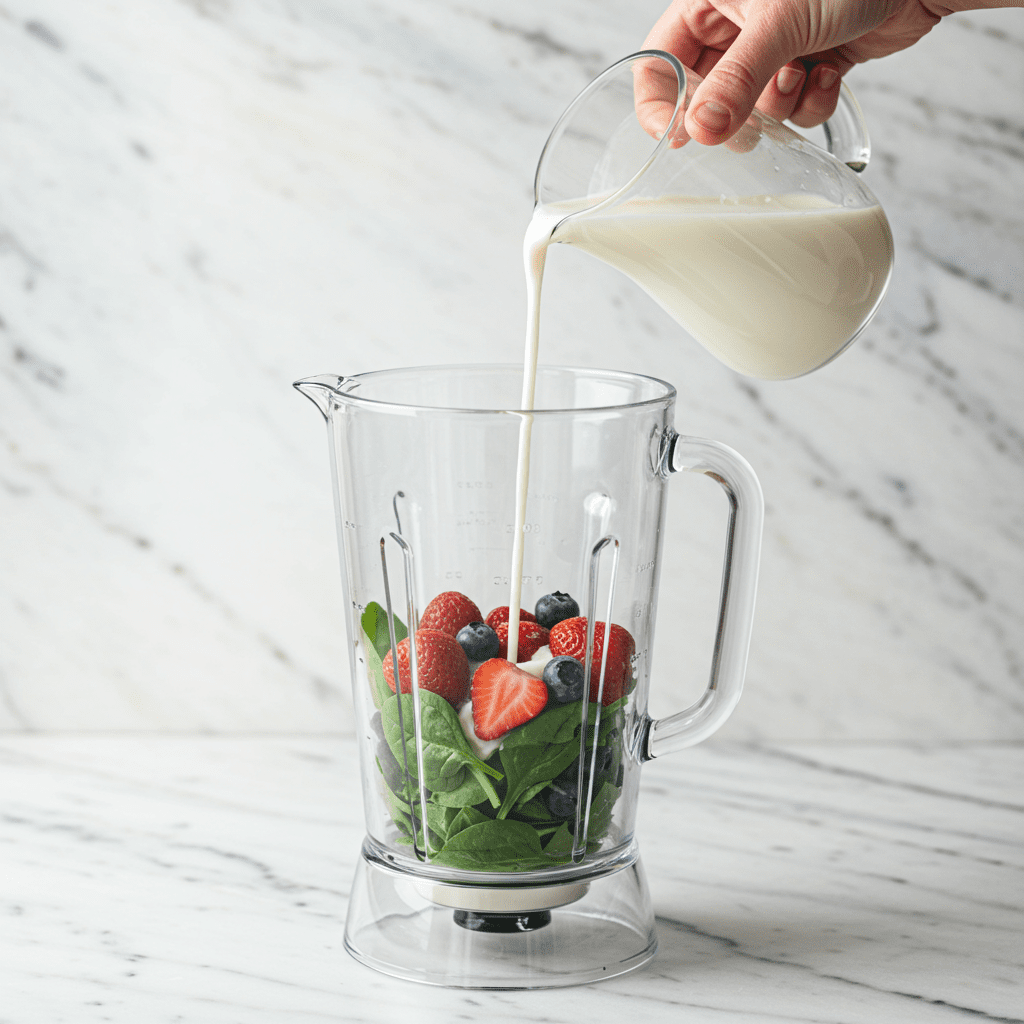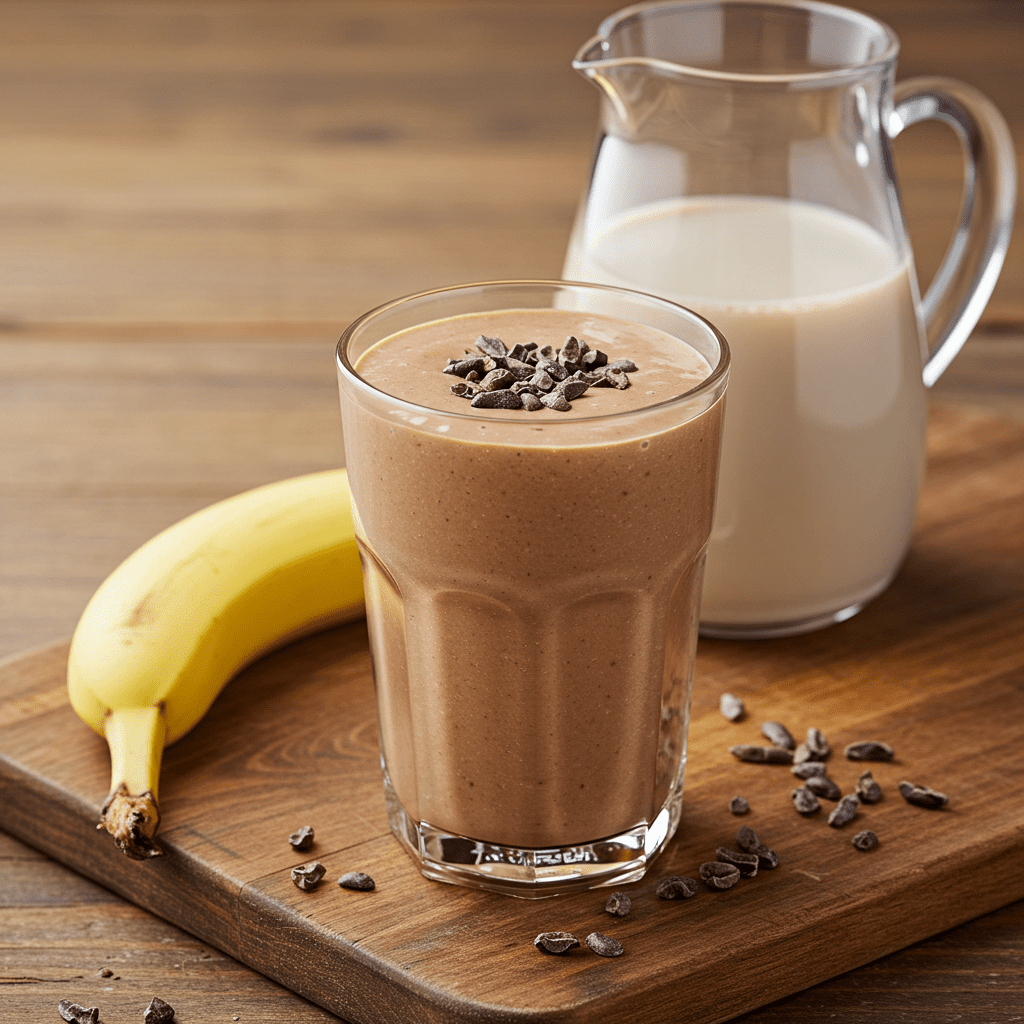What Is the Best Liquid to Use in a Smoothie? A Dietitian’s Guide

Ever stand in front of your blender, wondering if you should reach for the milk, a carton of juice, or just plain water?
You’re not alone.
As a registered dietitian, it’s one of the most common questions I get.
The liquid you choose is more than just a blending agent; it’s a critical ingredient that shapes the entire nutritional profile of your smoothie.
Your liquid base can turn a light, fruity snack into a satiating, high-protein meal.
It can add significant calories and sugar, or it can offer hydration with minimal impact.
This guide will walk you through the best liquid options, tailored to your specific health goals, so you can blend with confidence.
Why Your Smoothie Liquid Matters More Than You Think

The liquid in your smoothie does more than just help the blades spin—it sets the stage for the entire drink. It can be the difference between a 150-calorie snack and a 500-calorie meal. It dictates whether your smoothie will be creamy and satisfying or light and refreshing.
From a nutritional standpoint, the liquid affects three key areas:
1. Calorie & Sugar Content: Juices and sweetened milks can add hundreds of calories and dozens of grams of sugar before you even add fruit.
2. Protein & Fat: Some liquids, like soy milk or whole milk, add a significant amount of protein and fat, which promotes satiety—the feeling of being full and satisfied. Research from the American Journal of Clinical Nutrition consistently shows that protein is the most satiating macronutrient.
3. Nutrient Density: Some options are fortified with calcium and vitamin D, while others, like coconut water, provide electrolytes like potassium.
Thinking about your goal first is the key. Are you making a post-workout recovery shake, a quick breakfast, or a light afternoon hydrator? The answer will point you to the perfect liquid base.
Which Liquids Make Smoothies Creamy and Satisfying?

If you crave a smoothie with a rich, velvety texture that feels more like a healthy milkshake, your liquid choice is paramount.
These options are perfect for smoothies with ingredients like banana, peanut butter, chocolate, or avocado.
Dairy Milk: An excellent source of high-quality protein and bone-building nutrients.
Whole milk will give you the richest texture due to its fat content.
For a protein boost without as much fat, I often recommend ultra-filtered milk (like Fairlife), which is lower in sugar and contains about 13 grams of protein per cup.
Oat Milk: This is the undisputed champion of creaminess in the plant-based world.
Its naturally sweet flavor and creamy consistency come from its carbohydrate content.
A typical cup of unsweetened oat milk has around 120 calories and 2-4 grams of protein.
Because it’s higher in carbs and lower in protein than other milks, I recommend pairing it with a protein source like Greek yogurt or a scoop of protein powder.
Soy Milk: A fantastic dairy-free option that doesn’t sacrifice protein.
With about 80-100 calories and 7-9 grams of complete protein per cup, it provides both creaminess and staying power.
According to Harvard T.H. Chan School of Public Health, soy is a source of beneficial polyphenols called isoflavones.
Look for unsweetened varieties to keep sugar in check.
What’s the Best Option for a Low-Calorie Smoothie?

When your goal is hydration or a light snack that won’t weigh you down, you’ll want a liquid with minimal calories, sugar, and fat.
These are great for green smoothies or fruit-forward blends where you want the ingredients to shine.
Water: The ultimate zero-calorie mixer.
It’s hydrating, free, and accessible.
Using water ensures that all the calories and flavors come directly from your whole food ingredients like fruits, vegetables, and seeds.
The “con” is that it adds no creaminess, so your smoothie will be thinner and more juice-like.
Unsweetened Almond Milk: A go-to choice for a low-calorie base with a hint of creaminess.
At only 30-40 calories per cup, it’s a significant calorie saver compared to other milks.
The tradeoff, as noted by the USDA’s FoodData Central, is that it contains only about 1 gram of protein, so it won’t contribute much to satiety on its own.
Coconut Water: Technically a juice, coconut water is the clear liquid from inside young coconuts.
It’s prized for being a natural source of electrolytes, especially potassium, which is vital for hydration and muscle function.
A cup has about 45-60 calories and around 11 grams of natural sugar.
It’s fantastic for post-workout smoothies but has a distinct flavor that works best with tropical fruits.
How Can I Add a Protein Punch with Just the Liquid?

For a smoothie to function as a true meal replacement or a post-workout recovery tool, it needs a substantial amount of protein.
Choosing a high-protein liquid is the easiest way to get there.
Ultra-Filtered Dairy Milk: As mentioned, this is a top-tier choice.
By filtering the milk, more protein and calcium are retained while much of the natural sugar (lactose) is removed.
A cup can pack up to 13 grams of protein.
Soy Milk: The powerhouse of plant-based milks.
It’s a complete protein, meaning it contains all nine essential amino acids, making it nutritionally comparable to cow’s milk.
With 7-9 grams of protein per serving, it’s an excellent and widely available choice.
Pea Milk: A newer player in the plant-based milk aisle, pea milk is a nutritional superstar.
Made from yellow peas, it’s hypoallergenic and typically contains about 8 grams of protein per cup, putting it on par with soy and dairy milk.
Brands like Ripple are often fortified with nutrients like Vitamin D, calcium, and DHA omega-3s.
Its flavor is generally considered more neutral than soy, making it very versatile.
Should I Ever Use Fruit Juice in a Smoothie?

This is a question I address carefully in my practice.
While 100% fruit juice comes from fruit, it’s not nutritionally equivalent to eating the whole fruit.
The juicing process removes nearly all of the dietary fiber, which is crucial for slowing down sugar absorption.
A single cup of apple juice can contain 24 grams of sugar—nearly the same as a can of soda.
While these are natural sugars, the lack of fiber means they hit your bloodstream quickly, which can spike blood sugar.
The American Heart Association recommends limiting added sugar, and while juice isn’t “added” sugar, its effect on the body is similar without the buffering effect of fiber.
My Professional Advice: Use 100% fruit juice as a flavor enhancer, not a primary liquid.
If a green smoothie tastes too “earthy,” adding a splash (¼ cup or less) of pineapple or orange juice can make it much more palatable.
A better strategy is to use water or milk as your base and add whole or frozen fruit for sweetness and fiber.
Conclusion
Choosing the right liquid for your smoothie is less about finding a single “best” option and more about understanding your own nutritional needs and taste preferences.
The liquid is a foundational ingredient that can transform your smoothie from a simple snack into a protein-packed meal, a low-calorie hydrator, or a creamy, satisfying treat.
By thinking about your goal first—whether it’s building muscle, managing weight, or simply enjoying a delicious blend—you can make an informed choice.
Don’t be afraid to experiment!
Try mixing liquids, like half water and half coconut water, or pairing different milks with different flavor profiles.
The most nutritious smoothie is the one you enjoy making and drinking consistently.
